 *Thailand is a country located in Southeast Asia, and it shares borders with several countries:
*Thailand is a country located in Southeast Asia, and it shares borders with several countries:
– Malaysia: To the south
– Cambodia: To the east
– Laos: To the northeast
– Myanmar: To the northwest
Thailand is divided into 77 provinces, also known as “changwat” in Thai. These provinces are further divided into 878 districts, also known as “amphoe” in Thai.
The provinces of Thailand can be grouped into 5 main regions:
– Northern Thailand: 17 provinces
– Northeastern Thailand: 19 provinces
– Central Thailand: 21 provinces
– Eastern Thailand: 7 provinces
– Southern Thailand: 14 provinces
The capital city of Thailand is Bangkok, which is a special administrative area and the country’s largest city. Bangkok is a hub for business, culture, and tourism, and is known for its rich history, vibrant nightlife, and delicious cuisine.
Thailand’s Prime Minister
Thailand’s Prime Minister is Paetongtarn Shinawatra, and his party, Pheu Thai, won the 2023 general election.
*Thailand…..
Thailand, formerly known as Siam, is a country located in Southeast Asia, bordered by Laos, Cambodia, Malaysia, and Myanmar. The history of Thailand dates back around 10,000 years, when humans first settled in the region.
- Ancient Period
Thailand was originally a Hindu country, which later came under the influence of Buddhism.The royal family was heavily influenced by Hinduism, and the king was considered an incarnation of Lord Vishnu. The national symbol of Thailand is the Garuda, which is a mythical bird in Hindu mythology that is the mount of Lord Vishnu. - Modern Period
In 1238, the Sukhothai Kingdom was established, which is considered the first Buddhist Thai kingdom.In 1782, the Chakri dynasty was established in Bangkok, marking the beginning of modern Thailand. During World War II, Thailand was an ally of Japan, and later became an ally of the United States. In 1992, Thailand was declared a constitutional monarchy. - Culture
Buddhism and the monarchy play an important role in Thai culture. The influence of religion and the monarchy can be seen in daily life. Thai classical music is influenced by Chinese, Japanese, Indian, and Indonesian music.
- Thailand’s population is approximately 70 million, with 38 million workers, accounting for 55% of the total population. The workforce is diverse, comprising various ethnic groups:
Thai: The majority ethnic group, making up around 75% of the population. Chinese: A significant minority, comprising around 14% of the population. Malay: Primarily found in the southern provinces, making up around 3% of the population. Indigenous groups: Various ethnic groups, such as the Karen, Hmong, and Lisu, living in rural areas.
- The workforce is engaged in various occupations, with major industries including:
Agriculture: A significant industry, employing around 12.68 million people, with a 1% annual growth rate. Manufacturing: Growing at 2.1%, with foreign investment increasing in electronics, auto parts, and renewable energy. Transportation and storage: Growing at 4.6%. Tourism: A significant sector, with many Thais employed in hotels and restaurants, and the industry recovering after the pandemic.

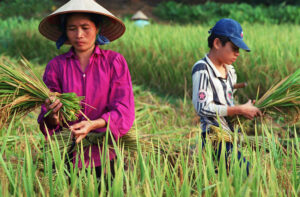
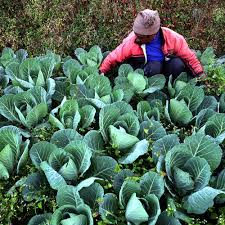
Thailand’s youth population is significant, with those under 24 years old making up a substantial portion of the workforce. However, youth unemployment rates have been affected by the pandemic. Key economic indicators include
GDP growth rate: Ranked 145th globally. Unemployment rate: 4%, with youth unemployment ranked 178th globally. Inflation rate: Ranked 24th globally. GDP per capita: Ranked 99th globally, with a nominal GDP of $515 billion in 2023.
The Thai government is focusing on initiatives like “Thailand 4.0”, which aims to transform the economy into a high-income, technology-driven nation, with a focus on innovation, high-tech industries, and infrastructure development. This initiative is a significant step towards transforming Thailand into a high-income economy.
Thailand’s* economy is primarily driven by agriculture, industry, and services. Agriculture plays a significant role, with rice, rubber, and fruits being major products. The industry sector is also prominent, with automotive, electronics, and textiles being key industries.Thailand is a constitutional monarchy, with a king as the head of state and a prime minister as the head of government. The country has a democratic system, where citizens have the right to vote and elect their representatives.Thailand’s education system includes primary, secondary, and higher education. Education is compulsory for children between the ages of 6 and 14. There are several universities in Thailand, including:
- Chulalongkorn University
- Mahidol University
- Thammasat University
Thailand’s youth are increasingly focused on technology and digital media. Social media is widely used, and online platforms are popular. Education and career opportunities are also a priority, with many young people striving to improve their future prospects.
Some key interests among Thailand’s youth include:
- Technology and digital media
- Education and career opportunities
- Travel and tourism
- Music and arts
- Sports and fitness
It’s worth noting that Thailand’s youth have diverse interests and priorities, and they shape their lives according to their individual passions and goals.The relationship between India and Thailand is strong and historical. Both countries have defined their relationship as a strategic partnership, focusing on security, trade, and cultural exchange.
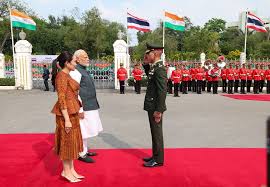 Recently, several agreements have been signed between India and Thailand
Recently, several agreements have been signed between India and Thailand
- Anti-Human Trafficking Agreement: Both countries have agreed to work together to combat human trafficking and illegal migration.
- Security Agencies Agreement: India and Thailand have agreed to establish a strategic dialogue between their security agencies.
- Buddhist Heritage Conservation Agreement: The Gujarat government and Thailand’s Bodh Gaya Vijayalay-980 Institute have signed an agreement to conserve and promote Buddhist heritage sites.
- Mekong Ganga Dhamma Yatra: India and Thailand are promoting cultural exchange through the Mekong Ganga Dhamma Yatra.
*Famous things in Thailand:
- Food: Thai cuisine is world-renowned, featuring dishes like Tom Yum soup, Green Curry, and Pad Thai.
- Temples: Thailand is home to many beautiful and historic temples, such as Wat Phra Kaew and Wat Arun.
- Dance: Thai dance, including Ram Thai and Fon Nam, is highly acclaimed.
- Festivals: Thailand celebrates many colorful festivals, including Songkran and Loy Krathong.
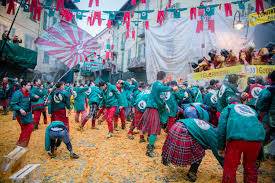
Thailand’s national anthem:
- National anthem: “Phleng Chat” (Thai: เพลงชาติ) was composed in 1932.
- Lyrics: The lyrics of “Phleng Chat” reflect Thailand’s history and culture.
Thailand national anthem lyrics:
- “Phleng Chat”
(Thai: เพลงชาติ)
“ประเทศไทยรวมเลือดเนื้อชาติเชื้อไทย
เป็นประชารัฐ ไผทของไทยทุกส่วน
อยู่ดำรงคงไว้ได้ทั้งมวล
ด้วยไทยล้วนหมาย รักสามัคคี
ไทยนี้รักสงบ แต่ถึงรบไม่ขลาด
เอกราชจะไม่ให้ใครขมขี่
สละเลือดทุกหยาดเป็นชาติพลี
เถลิงประเทศชาติไทยทวี มีชัย ชโย
****In English****
“Thailand, the land of our ancestors,
Where our people live in harmony,
Our nation, our pride, we will defend,
With unity, we will forever stand.
We love peace, but we will not be afraid,
Our independence will never be compromised,
We will sacrifice everything for our nation,
Long live our great nation, Thailand, victory and joy!”
- Indian perceptions of Thailand:
Buddhist connection: Both Thailand and India have a significant Buddhist influence. Thailand’s Theravada Buddhism has its roots in India. Cultural connection: Thailand and India have a long-standing cultural connection. Many Indian cultural symbols, such as Hindu temples and Buddhist stupas, can be found in Thailand. Trade connection: Thailand and India have a long history of trade relations. Indian goods have a significant market in Thailand, and Thai goods are also popular in India.
- Relationship between Thailand and India:

Diplomatic relations: Thailand and India have excellent diplomatic relations. Both countries have signed several agreements, including trade and security pacts. Cultural exchange: Thailand and India have a rich cultural exchange program. Both countries have hosted several cultural events, including music and dance festivals. Trade cooperation: Thailand and India have a strong trade cooperation. Both countries have signed several trade agreements, including a free trade agreement.
Overall, Thailand and India have a strong and positive relationship, with a long history of cultural, trade, and diplomatic ties.
- Thailand’s democracy is a parliamentary system where the king serves as the head of state, and the prime minister is the head of government. The country’s political landscape is characterized by a multi-party system.
- Key Features of Thailand’s Democracy:
Parliamentary System: Thailand has a parliamentary system with a 500-member national assembly. Constitutional Monarchy: The king serves as the head of state but has limited powers.Prime Minister: The prime minister is the head of government and determines the country’s policies.
- What Drives Success for Thai Youth?
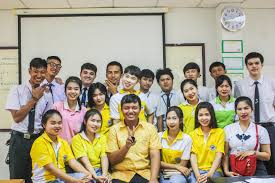
Thai youth focus on several key areas to achieve success:
Education: Education is highly valued, and students strive to achieve high academic standards.Entrepreneurship Many young Thais are interested in starting their own businesses. Technology: Technology plays a significant role in helping Thai youth achieve their goals. Culture: Preserving Thai culture is also essential for the younger generation.
- Essential Qualities for Success:
To succeed, Thai youth emphasize the importance of:
Motivation: Staying motivated is crucial for achieving goals. Hard Work: Thai youth believe in putting in the effort required to succeed. Decision-Making: Making informed decisions is vital for achieving success
- The majority of people in Thailand believe in Buddhism. Theravada Buddhism has a significant influence in Thailand, and it is an integral part of the country’s culture and society.Influence of Buddhism in Thailand:
Buddhist Temples: Thailand has numerous Buddhist temples, which are symbols of the country’s culture and religion.Buddha Images: Buddha images are highly revered in Thailand, and they are considered sacred. Buddhist Teachings: Buddhism is practiced in Thailand, and its teachings are applied in daily life.
Thai People’s Belief in Buddhism: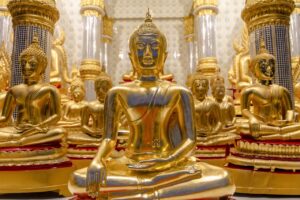
Religious Devotion: Thai people are devoted to Buddhism, and they strive to follow its teachings in their daily lives. Pilgrimages to Buddhist Temples: Thai people visit Buddhist temples to worship and meditate.Buddhist Festivals: Thai people celebrate Buddhist festivals, such as Vesak, which commemorates the birth of Buddha.
Quotes from Thai Writers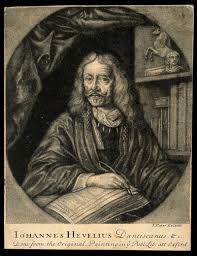
- “The Thai people are a resilient and resourceful nation, capable of overcoming even the greatest challenges.” – Kukrit Pramoj (Thai writer and politician)
- “The beauty of Thai culture lies in its diversity and richness, a true reflection of the country’s complex history.” – Sriburapha (Thai writer and historian)
- “The beauty of Thailand lies not only in its stunning beaches and lush forests, but also in the kindness and generosity of its people.” – John Smith
- “Thailand is a land of contrasts, where ancient traditions and modern innovations coexist in a vibrant and dynamic way.” – Maria Rodriguez
- “The food in Thailand is a reflection of the country’s rich cultural heritage, with a blend of spicy, sour, sweet, and savory flavors that tantalize the taste buds.” – David Lee
- “Thailand is a country that will leave you with unforgettable memories, from the bustling streets of Bangkok to the peaceful temples of Chiang Mai.” – Emily Chen
____________________________________________________________**********